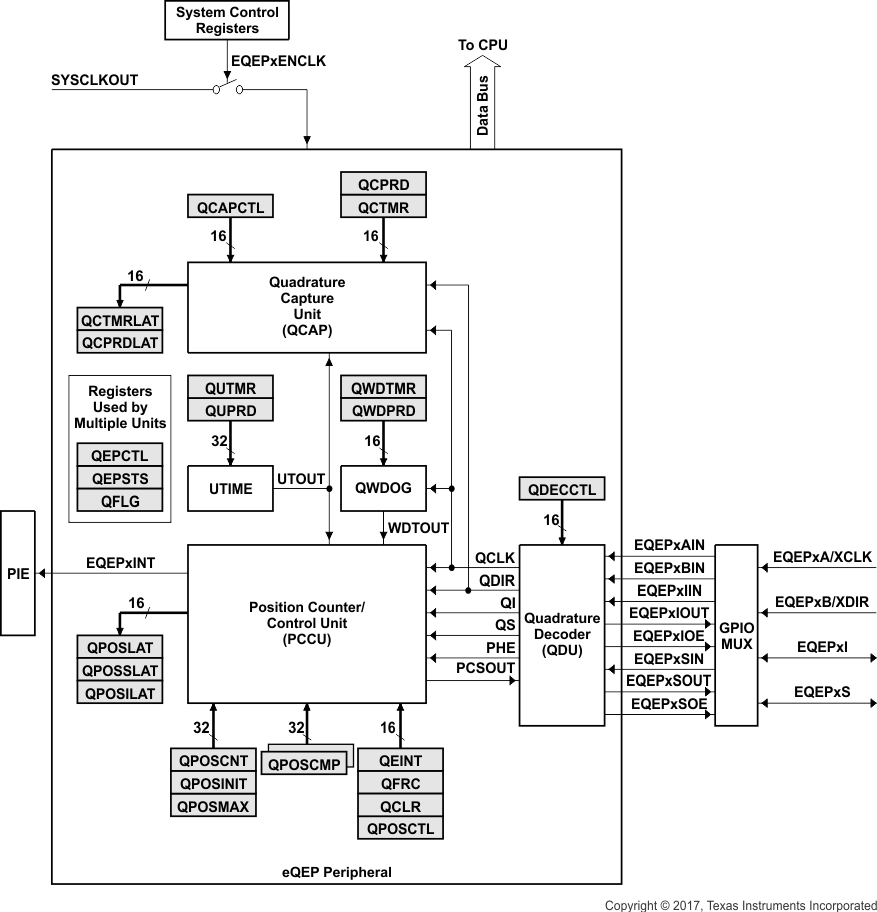SPRSP25A June 2018 – July 2018 TMS320F28035-EP
PRODUCTION DATA.
- 1Device Overview
- 2Revision History
- 3Terminal Configuration and Functions
-
4Specifications
- 4.1 Absolute Maximum Ratings
- 4.2 ESD Ratings
- 4.3 Power-On Hours (POH) Limits
- 4.4 Recommended Operating Conditions
- 4.5 Power Consumption Summary
- 4.6 Electrical Characteristics
- 4.7 Thermal Resistance Characteristics
- 4.8 Thermal Design Considerations
- 4.9 Emulator Connection Without Signal Buffering for the MCU
- 4.10 Parameter Information
- 4.11 Test Load Circuit
- 4.12 Power Sequencing
- 4.13 Clock Specifications
- 4.14 Flash Timing
-
5Detailed Description
- 5.1
Overview
- 5.1.1 CPU
- 5.1.2 Control Law Accelerator (CLA)
- 5.1.3 Memory Bus (Harvard Bus Architecture)
- 5.1.4 Peripheral Bus
- 5.1.5 Real-Time JTAG and Analysis
- 5.1.6 Flash
- 5.1.7 M0, M1 SARAMs
- 5.1.8 L0 SARAM, and L1, L2, and L3 DPSARAMs
- 5.1.9 Boot ROM
- 5.1.10 Security
- 5.1.11 Peripheral Interrupt Expansion (PIE) Block
- 5.1.12 External Interrupts (XINT1–XINT3)
- 5.1.13 Internal Zero Pin Oscillators, Oscillator, and PLL
- 5.1.14 Watchdog
- 5.1.15 Peripheral Clocking
- 5.1.16 Low-power Modes
- 5.1.17 Peripheral Frames 0, 1, 2, 3 (PFn)
- 5.1.18 General-Purpose Input/Output (GPIO) Multiplexer
- 5.1.19 32-Bit CPU-Timers (0, 1, 2)
- 5.1.20 Control Peripherals
- 5.1.21 Serial Port Peripherals
- 5.2 Memory Maps
- 5.3 Register Maps
- 5.4 Device Emulation Registers
- 5.5 VREG/BOR/POR
- 5.6 System Control
- 5.7 Low-Power Modes Block
- 5.8 Interrupts
- 5.9
Peripherals
- 5.9.1 Control Law Accelerator (CLA) Overview
- 5.9.2 Analog Block
- 5.9.3 Detailed Descriptions
- 5.9.4 Serial Peripheral Interface (SPI) Module
- 5.9.5 Serial Communications Interface (SCI) Module
- 5.9.6 Local Interconnect Network (LIN)
- 5.9.7 Enhanced Controller Area Network (eCAN) Module
- 5.9.8 Inter-Integrated Circuit (I2C)
- 5.9.9 Enhanced PWM Modules (ePWM1/2/3/4/5/6/7)
- 5.9.10 High-Resolution PWM (HRPWM)
- 5.9.11 Enhanced Capture Module (eCAP1)
- 5.9.12 High-Resolution Capture (HRCAP) Module
- 5.9.13 Enhanced Quadrature Encoder Pulse (eQEP)
- 5.9.14 JTAG Port
- 5.9.15 General-Purpose Input/Output (GPIO) MUX
- 5.1
Overview
- 6Applications, Implementation, and Layout
- 7Device and Documentation Support
- 8Mechanical, Packaging, and Orderable Information
Package Options
Mechanical Data (Package|Pins)
- PN|80
Thermal pad, mechanical data (Package|Pins)
Orderable Information
5.9.13 Enhanced Quadrature Encoder Pulse (eQEP)
The device contains one enhanced quadrature encoder pulse (eQEP) module.
Table 5-57 eQEP Control and Status Registers
| NAME | eQEP1
ADDRESS |
eQEP1
SIZE(x16)/ #SHADOW |
REGISTER DESCRIPTION |
|---|---|---|---|
| QPOSCNT | 0x6B00 | 2/0 | eQEP Position Counter |
| QPOSINIT | 0x6B02 | 2/0 | eQEP Initialization Position Count |
| QPOSMAX | 0x6B04 | 2/0 | eQEP Maximum Position Count |
| QPOSCMP | 0x6B06 | 2/1 | eQEP Position-compare |
| QPOSILAT | 0x6B08 | 2/0 | eQEP Index Position Latch |
| QPOSSLAT | 0x6B0A | 2/0 | eQEP Strobe Position Latch |
| QPOSLAT | 0x6B0C | 2/0 | eQEP Position Latch |
| QUTMR | 0x6B0E | 2/0 | eQEP Unit Timer |
| QUPRD | 0x6B10 | 2/0 | eQEP Unit Period Register |
| QWDTMR | 0x6B12 | 1/0 | eQEP Watchdog Timer |
| QWDPRD | 0x6B13 | 1/0 | eQEP Watchdog Period Register |
| QDECCTL | 0x6B14 | 1/0 | eQEP Decoder Control Register |
| QEPCTL | 0x6B15 | 1/0 | eQEP Control Register |
| QCAPCTL | 0x6B16 | 1/0 | eQEP Capture Control Register |
| QPOSCTL | 0x6B17 | 1/0 | eQEP Position-compare Control Register |
| QEINT | 0x6B18 | 1/0 | eQEP Interrupt Enable Register |
| QFLG | 0x6B19 | 1/0 | eQEP Interrupt Flag Register |
| QCLR | 0x6B1A | 1/0 | eQEP Interrupt Clear Register |
| QFRC | 0x6B1B | 1/0 | eQEP Interrupt Force Register |
| QEPSTS | 0x6B1C | 1/0 | eQEP Status Register |
| QCTMR | 0x6B1D | 1/0 | eQEP Capture Timer |
| QCPRD | 0x6B1E | 1/0 | eQEP Capture Period Register |
| QCTMRLAT | 0x6B1F | 1/0 | eQEP Capture Timer Latch |
| QCPRDLAT | 0x6B20 | 1/0 | eQEP Capture Period Latch |
| Reserved | 0x6B21 – 0x6B3F | 31/0 |
For more information on the eQEP, see the TMS320x2803x Piccolo Enhanced Quadrature Encoder Pulse (eQEP) Module Reference Guide.
Figure 5-40 shows the eQEP functional block diagram.
 Figure 5-40 eQEP Functional Block Diagram
Figure 5-40 eQEP Functional Block Diagram